
Blending, in yarn production, process of mixing fibres of various origins, length, thickness, or colour to make yarn. Fabrics made from such fibres are called blends. Blending also refers to the process of combining small amounts of the same fibre taken from different lots to achieve a uniform result.
Characteristics
Characteristics of blended yarns like – shrink or not, water absorbent, has creases or not, has the lustre or not, soft/hard. Each kind of fibre has its own characteristics when mixing them, one should consider their characteristics to create a hybrid with the characteristics needed.
The blended yarn is the yarn which has several types of fibres blended together. they exclude a blended characteristic which is completely unique. mainly two or more constituents are blended together to get a desired product.
Types of Blended Yarn
Cotton and Polyester
It is the most demanded and enduring blend that trend in the textile market. The strength and lustre of polyester blends with the softness and breathability of cotton, wonders happen. A plethora of apparel types are made using the cotton-polyester blend. In most of the cases, cotton is included in a bigger amount than polyester to maintain the comfort, skin-friendly characteristic and breathability of the fabric blend. Cotton is mainly included around 65% and the amount of polyester in the blend remains around 35%. Other common cotton-polyester blends are 67%-33%, 50%-50%, 52%-48% and 70%-30%. Shirts, sportswear, blouses and general outfits are the major types of apparel made from cotton-polyester blended yarns
Cotton and Viscose
This type of blend is usually preferred to attain additional comfort and uniformity in the fabric. Viscose fabrics are pretty low in demand but when it is mixed with high-quality cotton, a great comfort can be attained. The part of cotton is mainly higher than viscose in the blended fabrics. 85%-15% and 70%-30% are the common cotton-viscose blended yarns that can be seen in the market.
Characteristics
Characteristics of blended yarns like – shrink or not, water absorbent, has creases or not, has the lustre or not, soft/hard. Each kind of fibre has its own characteristics when mixing them, one should consider their characteristics to create a hybrid with the characteristics needed.
The blended yarn is the yarn which has several types of fibres blended together. they exclude a blended characteristic which is completely unique. mainly two or more constituents are blended together to get a desired product.
Types of Blended Yarn
- Polyester Cotton Yarn Spun Blends Cotton Acrylic Yarns
- Polyester Viscose Blended Yarn Spun Blend Cotton Nylon Yarns
- Core spun, Rubber Coated, Stretch Yarns Spun Blend Cotton Rayon Yarn
- Melange Yarn Spun Blend Cotton Wool Yarn
- Fancy Grindle Yarn Spun Blend Linen Yarn
- Spun-Blends Acrylic Polyester Spun Blend Cotton Polyester
Cotton and Polyester
It is the most demanded and enduring blend that trend in the textile market. The strength and lustre of polyester blends with the softness and breathability of cotton, wonders happen. A plethora of apparel types are made using the cotton-polyester blend. In most of the cases, cotton is included in a bigger amount than polyester to maintain the comfort, skin-friendly characteristic and breathability of the fabric blend. Cotton is mainly included around 65% and the amount of polyester in the blend remains around 35%. Other common cotton-polyester blends are 67%-33%, 50%-50%, 52%-48% and 70%-30%. Shirts, sportswear, blouses and general outfits are the major types of apparel made from cotton-polyester blended yarns
Cotton and Viscose
This type of blend is usually preferred to attain additional comfort and uniformity in the fabric. Viscose fabrics are pretty low in demand but when it is mixed with high-quality cotton, a great comfort can be attained. The part of cotton is mainly higher than viscose in the blended fabrics. 85%-15% and 70%-30% are the common cotton-viscose blended yarns that can be seen in the market.


